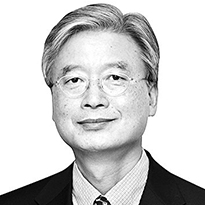Cho Yoon-je
The author is a special appointment professor at Yonsei University School of Economics.
Just a year or two ago, the dominant narrative in the West was “Peak China.” Many conservative scholars and commentators argued that China had reached the limits of its system and would never catch up to the United States, especially under Washington’s increasingly aggressive containment policies. Recently, that claim has faded. The world is once again watching China with a mix of surprise and unease, especially following the emergence of DeepSeek and the striking resurgence of Huawei.
Beneath these headline events lies a decade of steady scientific and technological ascent. China’s volume of published and cited research papers and its number of patent applications have surged past those of the United States, a trend that began three years ago. This rise in science and technology — often referred to as China’s tech “great leap” — is now reshaping global perceptions.
![A robot player of the Mountain Sea team from China Agricultural University, center, competes during an AI-powered robot football match in Beijing on June 28. Four teams from three Chinese universities competed in the tournament, and the championship was clinched by the THU Robotics team from Tsinghua University. [XINHUA/YONHAP]](https://koreajoongangdaily.joins.com/data/photo/2025/08/01/72a04112-ef97-4eb9-b850-2d4b627a2ffe.jpg)
A robot player of the Mountain Sea team from China Agricultural University, center, competes during an AI-powered robot football match in Beijing on June 28. Four teams from three Chinese universities competed in the tournament, and the championship was clinched by the THU Robotics team from Tsinghua University. [XINHUA/YONHAP]
The trade and technology restrictions imposed since U.S. President Donald Trump’s first term have ironically accelerated China’s technological capabilities. High tariffs on Chinese exports and sanctions targeting semiconductors and advanced technologies spurred domestic innovation, expanded chip production and advanced AI and robotics. Chinese manufacturers integrated these advances into production, achieving efficiency gains and cost reductions.
China is no longer the low-cost assembly hub of 20 years ago. It now produces 80 percent of the world’s solar panels, with prices down 70 percent over the past decade, securing dominance in renewable energy. Its EVs and batteries are conquering global markets, not through dumping but through AI integration, domestic competition-driven automation and strong government support for industrial ecosystems. In drones and humanoid robotics, China has already become the primary global player.
![People visit the stand of Huawei during the MWC at the Shanghai New International Expo Centre in Shanghai on June 18. [AFP/YONHAP]](https://koreajoongangdaily.joins.com/data/photo/2025/08/01/5c0b81db-8087-40fb-b7e6-87ef64d99e13.jpg)
People visit the stand of Huawei during the MWC at the Shanghai New International Expo Centre in Shanghai on June 18. [AFP/YONHAP]
Analysts point to three factors behind this rapid transformation. The first is education and talent. Annual university graduates grew from 1 million in 1999 to 12 million today, with half specializing in STEM fields. China produces five times as many STEM graduates and seven times as many engineers as the United States, even adjusted for population. This talent pool drives product development, after-sales service and manufacturing process improvements. From elementary school, China operates gifted programs that have produced figures like Liang Wenfeng of DeepSeek. Massive investment in higher education has also placed eight Chinese universities in the global top 10 for engineering and technology.
The second factor is the combination of a vast domestic market and state support. Advanced manufacturing and technology require immense initial investment and economies of scale. Companies that survive fierce domestic competition receive government procurement opportunities and gain further cost advantages, enabling them to dominate global markets.
The third is the governance model itself. Central authorities provide planning and support, local governments compete for performance and firms fight for survival in the marketplace. This creates a dynamic ecosystem for advanced manufacturing. At its core is the Communist Party, which coordinates central and local governments, state-owned enterprises, financial institutions, and research institutes. The combination of vertical planning with horizontal market competition has produced rapid growth, though it also brings repression of individual freedoms, worsening inequality and structural imbalances that cloud China’s future.
China’s emergence as a scientific and advanced manufacturing powerhouse will have profound global repercussions. In the 1970s, Japanese electronics, semiconductors and automobiles began to overwhelm U.S. products. In the 1990s, Korea followed with similar successes. At those times, Japan and Korea each had roughly half of the U.S. per capita income. Today, China is challenging U.S. technological and industrial supremacy with a per capita income that is only 16 percent of the United States. The geopolitical, economic and security consequences could be far-reaching.
![A giant screen shows news footage of Chinese President Xi Jinping shaking hands with DeepSeek founder Liang Wenfeng during a symposium on private enterprises at a shopping complex in Beijing on Feb. 17. [REUTERS/YONHAP]](https://koreajoongangdaily.joins.com/data/photo/2025/08/01/b3456015-aaf2-4b9c-bbc8-dae6cf8f1425.jpg)
A giant screen shows news footage of Chinese President Xi Jinping shaking hands with DeepSeek founder Liang Wenfeng during a symposium on private enterprises at a shopping complex in Beijing on Feb. 17. [REUTERS/YONHAP]
Debate over economic governance models is likely to intensify. The 20th century ended with capitalism prevailing over communism. In the 21st century, the contest is between state capitalism and market capitalism. Nobel laureates Daron Acemoglu and James Robinson have argued that the quality of institutions determines national prosperity. Which system can generate sustainable economic dynamism remains an open question.
For Korea, the lesson is urgent. Without a sweeping overhaul of its national governance and economic strategy, it will be difficult to navigate the powerful currents unleashed by China’s technological rise. The global wave is building, and the question is whether Korea can ride it — or be swept under.
Translated from the JoongAng Ilbo using generative AI and edited by Korea JoongAng Daily staff.


